F L O R I D A
 W I L D L I F E
W I L D L I F E
 W I L D L I F E
W I L D L I F E
Trouble, a handsome Bald Eagle is available for "adoption" at the Florida Audubon Society Center for Birds of Prey in Maitland, Florida.
Smedley, an injured Osprey is awaiting your donations. TAKE A BIRD UNDER YOUR WING at the Audubon Center for Birds of Prey, This is one of the premier raptor rehab facilities in the nation. As the name suggests, it specializes in top-of-the-food-chain predators and scavengers: hawks, kestrels, falcons, owls, kites, ospreys, caracaras, vultures and eagles. The center receives between 500 and 600 injured or orphaned birds annually. Since it opened in 1979, more than 8,000 birds have been treated at the center; more than 3,500 -- including 206 bald eagles -- have been released back into the wild. Some birds that can't be released are kept on display. When the center reopens this summer after a major expansion project, Project Wingspread, it will have more than 70 birds of 21 species with whom humans can go eye-to eye. The expansion will also let people get a look behind the scenes -- literally -- into the workings of a raptor rehab center. Outside will be a butterfly garden, an urban wetlands demonstration project and a boardwalk and gazebo from which people can get a look at the new and improved flight area for recuperating birds. The Center holds an annual Baby Owl Shower each Spring - people bring in baby gifts such as blankets and money for the little owlets. The Adopt-a-Bird program is a major source of funding for the Center. This program allows individuals to become adoptive parents of specific permanently injured birds with contributions helping to offset the cost of food and care.. Adoptions start as low as $25 and include an adoption certificate, color photo, bio and species info, free admission to the Center and a subscription to the Florida Raptor News. Learn more about the program at their website. Photos above courtesy Audubon Society center for Birds of Prey
Birding Equipment, Etiquette & Economics Resident birds can be seen, if you're lucky, pretty much year-round. Migratory species are best spotted from mid-April to mid-May and again in October. One of the reasons that Florida is so bird-rich is it's unique geographic placement between tropical and temperate regions. The other reason is that it has two important flyways, or migratory corridors, used by Caribbean birds, (such as on Jamaica vacations), and birds from as far away as the canadian prairies. If you want to see these species on this continent, Florida is the only place to do it. Some are tiny little warblers that fly 3,000 miles to get here. Many of these birds can also be seen on the other side of the continent, for example in Cancun because it is almost in the same climactic region, just not as close to the migrating paths. You can pretty much see birds everywhere here, even in urban areas. Nevertheless, some spots have particular charms: They're more populous, perhaps, or they attract a specific type of bird. Here are a few of the best: Merritt Island National Wildlife Refuge / Canaveral National Seashore -- Dense with mangroves, palms and pines and snaked with salty estuaries, Merritt Island National Refuge shelters more than 300 species of birds either all or part of the year. That total includes 15 species that have made the federal endangered or threatened lists. If you want to see a Florida scrub jay, Florida's state bird, this is the only bird that can be seen nowhere else anywhere (though there are many birds that, if you want to see them in North America or in the U.S., can only be seen here). The blue-gray Sunshine State natives are quite curious and will come so close, you can get a good look without binocs. Get your list ready: Other species include black-crowned herons, avocets, stilts, reddish egrets (the rarest heron species in Florida), a variety of ducks and our national symbol, the bald eagle. The best time to go is fall. The refuge, 140,000 acres just north of Kennedy Space Center and east of Titusville, is a major wintering area for migratory birds. It's also a popular place for Audubon Society field trips and for solo trips by local birders. The rookery island in the refuge’s Indian River Lagoon is a great place to see -- from a respectful distance -- a whole lot of birds courting, nesting, feeding and just hanging out. Osprey Outfitters of Titusville leads kayak tours around the island. Click here for the nearest hotel accomodations J.N "Ding" Darling National Wildlife Refuge, Sanibel Island --Half of Sanibel Island is given over to the refuge, which is one of the best places to see a lot of waterbirds in a short time. And it's easy -- you can even sit in your car and do it. Spoonbills, ospreys, various pelicans and a horde of ducks are here either all or part of the year. So are what renowned birder Roger Tory Peterson called the "glamour" birds: herons, egrets, ibis and others that congregate in the refuge's mangrove swamps. Red-shouldered hawks line the roadways. Also keep your eyes open for armadillos and gators. Sanibel is a primo spot for shellcollecting as well. see our section on Sanibel Island and the "Ding" Darling National Wildlife Refuge. Nearby Corkscrew Swamp Sanctuary has a wood stork colony with literally thousands of inhabitants. Swallow-tailed kites, woodpeckers and owls also live in this cypress swamp. Payne's Prairie -- This is another good spot to see Bartram's favorite, the sandhill crane, as well as pileated woodpeckers and Carolina wrens. Both wetland and upland species congregate here. Once a lake, this prairie south of Gainesville also is a favorite watering area for migratory birds. Best times to go, obviously, are spring and fall. There's a three-story observation tower with a telescope so you can get a really good look. Keep your eyes open for bigger animals as well. Bison, wild ponies and Cracker cattle roam the forested areas. Everglades National Park-- Where to start? Though bird species in the River of Grass have been decimated by the effects of development, there are still so many you need a calculator to count them. Look for spot-breasted orioles, red-whickered bulbuls, parakeets, parrots, pelicans, swallow-tailed kites, Cape Sable Seaside sparrows, Eastern screech owls and, for the fortunate few, a flamingo. St. Marks Wildlife Refuge -- If you've never seen a bald eagle's nest, this is the place. There's one right beside the road. This is a good place to watch hawks and falcons, too, as well as gannets, plovers and sandpipers. The beaches are unspoiled, the dunes are impressively tall and, if you're lucky twice, you might spot a sea turtle. Some of our state's feathered inhabitants are neither natives nor migrants, but transplants. Like their human counterparts, they're originally from somewhere else but took a liking to Florida and decided to stay. Many are escaped or released pets: budgies, parakeets, macaws, conures, mynas and a plethora of parrot species. Other exotics, as they're known, lived at the Miami Zoo until Hurricane Andrew blew open the doors of their enclosures in 1992. No matter how they came to be here, the Audubon Society considers them "locals" once they start nesting. But the Audubon Society also worries about the exotics and their effect on the local species. Like non-native plants and other animals, exotic birds can be "invasive, opportunistic and outcompete the natives," said an Audubon Society spokeswoman. Some can breed unnaturally fast, crowding out their neighbors. Others damage local birds' nests and destroy their eggs. The Audubon Society urges people to be responsible owners: don't release those pretty plumed pals to the "wild," and take precautions to make sure they don't escape. As bird-friendly as Florida may be, going on safari for them can be an iffy proposition, especially for a novice. Sightings depend on the time of year, time of day and many other variables. Males look different from females, the adults different from the young. Some species even change outfits with the seasons. And sometimes our fickle feathered friends are just somewhere else when we're ready to admire them. Luckily, there are places where you can be assured of success. Suncoast Seabird Sanctuary, Indian Shores (727-391-6211): This beachside facility takes care of thousands of injured and orphaned wild birds a year; the most recent record is 8,000-plus in 1997. Many of the patients are pelicans, which frequently are injured by fish hooks and monofilament fishing line. Close to 90 percent are released back into the wild. Between 500 and 700 birds are permanently disabled and live on the property in large mesh aviaries, where humans can walk through and admire them. The birds do breed in captivity, a spokeswoman said, and the babies are released. The
Conservancy of Southwest Florida, Naples (850/262-0304):
The Conservancy operates two nature centers. The rehab center and natural
history museum are in the city of Naples. Its rehab specialists treat
some 1,700 animals a year. In addition to birds, injured bear and bobcat
get help here, too. About 20 animals -- including eagles, owls, hawks,
pelicans, anhingas and other birds, as well as snakes and other creatures
-- are considered permanently disabled and are on display at the center. The Conservancy Briggs Nature Center is located in the Rookery Bay National Estuarine Research Reserve, a 12,700-acre tract of mangrove and sawgrass outside town. Winter is the best time to see a wide variety of wading birds, as well as a resident population of scrub jays. There's also a boardwalk, a butterfly garden and boat and canoe excursions. Busch Gardens, Tampa Yes, it's a theme park, but it has a sensitive, educational heart. "Lory Landing" opened in spring 1998 and features tropical birds from around the world. Lorikeets, for whom the exhibit is named, live in the free-flight aviary and are friendly enough to perch on your head. They share the facility, which also has enclosures for some residents, with hornbills, parrots, avocets, touracos, stilts, pheasants and others.
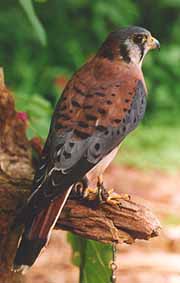
Elvis, a rare Kestral, a threatened species, is available for adoption.
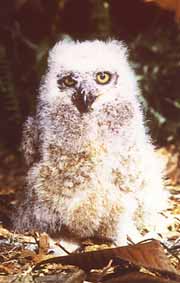
A former patient, Heinz, a Great Horned Owl, is now living in Central Florida.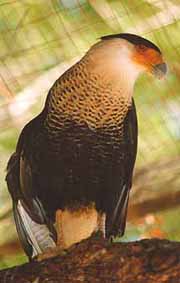
Juanita, of the threatened species Crested Caracara, also awaits adoption.
1101 Audubon Way, Maitland, FL32751 (407/644-0190)
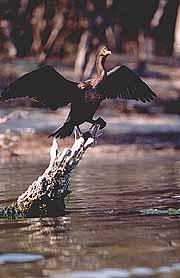
A Cormorant cooling off at the water's edge.
More Florida Wildlife

lorida's diverse habitats are home to a wide variety of plumed citizens, from tiny hummingbirds to huge herons, plain jays to exotic spoonbills, seed-eating buntings to predatory hawks and ospreys. There are more than 1,000 pairs of bald eagles here as well; only Alaska has more.
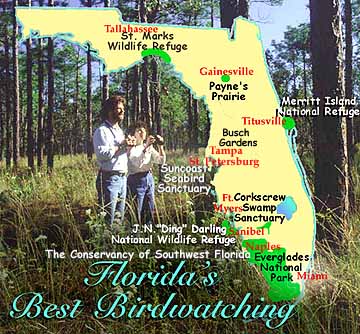
Use the interactive map above to find the best birding in your area.
Click here for the nearest campgrounds.